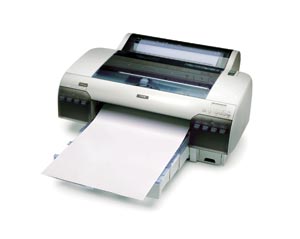HP recently added a new member to its world dominating series of wide format printers. The DesignJet 4000 not only features new levels of performance, but an impressive suite of remote print management software says Greg Corke.
Product: HP DesignJet 4000
Supplier: HP
Price: ú7,600
In the wide format printing market, colour inkjets have traditionally dominated the low-end and monochrome LEDs the high-end. In recent years though there has been a blurring of the edges with companies like Oce launching affordable monochrome volume printing solutions based on LED technology and HP raising the stakes with high throughput inkjets.
Another key differentiator has been the depth of software management tools that typically come with each technology. While your average LED solution is fully laden with a plethora of remote software tools to help manage the printer and document flow more effectively, such resources for your typical inkjet have been pretty thin on the ground. But things are starting to change.
18 months ago Oce took a new direction in the wide format inkjet market with the introduction of its ‘productive wide format colour’ solution, the TCS400, which offered the functionality and productivity typically found in monochrome LED systems in a full colour production level print solution.
Now HP has taken up the challenge and is offering the full complement of remote print management solutions in its brand new wide format offering, the A0+ DesignJet 4000. To facilitate this the DesignJet 4000 features a new Embedded Web Server, which enables administrators and users to manage the printer from anywhere in the world using a standard Web browser.
Users can remotely monitor printer, ink, and media status and usage and email alerts can also be provided when consumables are getting low. Multiple files can be submitted and each job can be previewed from the browser. Stored jobs can re-printed, queues can be managed, and accounting information can be viewed and saved in Excel and XML formats.
The Web-style interface looks extremely intuitive, and providing this level of remote management is sure to please those looking for flexibility and reliable throughput in their inkjet system. But while we’ve whetted the appetites of those that manage the system, what you all want to know is how fast you can get your drawings back and here the DesignJet 4000 is equally impressive.
Double Swath technology
- Prints up to 42” (1,067mm) wide
- 2,400 x 1,200dpi resolution
- Rolls up to 90m long
- Ink supplies of 225ml & 400ml for CMY, 400ml for K
- Embedded processor and 256MB (expandable up to 512MB)
- 40BG hard drive
- Ethernet 10/100Mbps
- Firewire
- Dimensions (1,930 x 800 x 1,350mm)
- Weight (115Kg)
Price from ú7,600
At the heart of the DesignJet 4000 is a new print technology called Double Swath. Put simply this means that the machine uses two print heads for each colour (Cyan Magenta, Yellow, Black), which nearly doubles the printable area in each pass, and of course the speed of printing. To accommodate this increased printing zone (which at 6cm, is double that of traditional wide format printers) HP had to develop a vacuum system, which works in conjunction with the media feeding system to ensure accurate delivery of the paper. Sucking the paper down not only means that the paper is held in place as the print heads pass over the print zone, but ensures that the media does not expand when it takes in ink. This is particularly critical when working with plain paper.
The main benefit of doubling the size of the print zone is of course a huge increase in print speeds. As a result, the DesignJet 4000 is able to print an A1 line drawing in an extremely impressive 25 secs, which is twice as fast as HP’s previous workhorse machine, the DesignJet 1000 series, three times faster than the DesignJet 500/800 series, and six times faster than the DesignJet 700 series.
Real speed
While raw printing speed is hugely important, so is the processing time required prior to printing, and for some this has been a major bottleneck with previous DesignJet models. HP claims that complex files can be printed up to five times faster than with the DesignJet 1000 series. HP quotes an example of a 340MB full colour GIS PDF printed on coated/best paper, which took 2mins 11secs to process and 5mins 15secs to print on the DesignJet 4000ps. The same file took the DesignJet 1055cm plus 24mins 9secs to process and 15mins 26secs to print. This is a significant difference I’m sure you’ll agree, but it’s probably worth pointing out that the DesignJet 4000ps includes an embedded RIP for Adobe PDF.
Equally impressive figures are quoted when carrying out simultaneous print jobs, as the DesignJet 4000 is able to carry out raster image processing and printing concurrently. As a result, HP claims that multiple jobs sets can be printed up to three times faster on the DesignJet 4000ps than with the DesignJet 1055cm plus.
All of this increased processing performance is made possible by a brand new embedded processor, 256MB memory (expandable up to 512MB) and an internal 40GB hard drive.
Conclusion
The new DesignJet 4000 series looks to be an extremely impressive piece of kit. Moving on from where the DesignJet 1000 series left off the new machine not only takes the inkjet market to new levels of performance (both in terms of raw print speed and concurrent processing), but brings an impressive suite of remote management tools to the table.
The DesignJet 4000 is a workhorse system designed to deliver serious throughput. There are cheaper machines out there, but none can match its speed of delivery, and the good news is it does all of this without compromising on all-important print quality.






